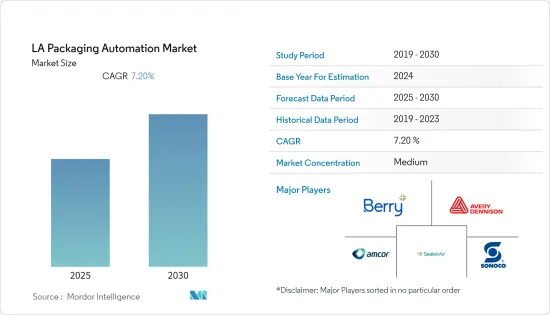PUBLISHER: Mordor Intelligence | PRODUCT CODE: 1628841

PUBLISHER: Mordor Intelligence | PRODUCT CODE: 1628841
LA Packaging Automation - Market Share Analysis, Industry Trends & Statistics, Growth Forecasts (2025 - 2030)
The LA Packaging Automation Market is expected to register a CAGR of 7.2% during the forecast period.

Key Highlights
- Before packaging automation made an impact in the region, packaging was a completely manual process. As competition increased, manufacturers took steps to reduce packaging costs and took measures to reduce costs by automating a variety of manual processes and raising the level of semi-automated processes.
- In Latin America today, consumers and governments are increasingly concerned about the environment and are increasingly interested in lighter, recyclable and reusable packaging. New labeling rules must be followed, especially in the food and beverage, bakery, and medical markets.
- In Mexico, companies are focusing on innovations in packaging products. For instance, in November 2021, Festo and Hybernya Industrial developed an automated packaging solution for multi-packs for Danone and Danup yogurts.
- Prior to the creation of the yogurt packaging industry in Mexico, it was a milestone for the Mexican yogurt packaging industry, given that there was no equipment in the country capable of processing this type of multi-sort packaging. This type of process was done manually by operators who took the product from each line and delivered it to the packaging machine.
- Brazil, Mexico, and Argentina are the main drivers for the region, with automated processes such as filling, labeling, bag egging, palletizing, and capping. Various businesses in food, pharmaceutical, cosmetic, personal care, beverage, and even warehouse are increasingly using these automation solutions to optimize business processes and reduce operating costs.
Latin America Packaging Automation Market Trends
Food and Beverage segment to hold biggest operating expense
As technology advances to become more flexible and configurable, companies are improving logistics and quality. Automation will continue to transform food and beverage manufacturing companies throughout the supply chain and to their customer's doors.
Consumer packaged goods companies need accurate and repeatable packaging processes. Individual packaging at high-cycle rates can be challenging, so companies that use robotics in their packaging lines can improve their throughput, efficiency, and quality. From raw product handling to primary packaging, secondary packaging, and palletizing, robotics has proven a high return on investment.
Packaging automation also involves greener solutions like recyclable, biodegradable, and refillable methods in the region. According to research conducted, Latin America has a low penetration for dishwashers, and hand washing is dominant where the plastic PET bottle is a dominant product pack and has increased its growth in terms of volume in this region.
Mexico to grow significantly in the industry
Latin America Packaging Automation Industry Overview
Additional Benefits:
TABLE OF CONTENTS
1 INTRODUCTION
- 1.1 Study Assumptions and Market Definition
- 1.2 Scope of the Study
2 RESEARCH METHODOLOGY
3 EXECUTIVE SUMMARY
4 MARKET INSIGHTS
- 4.1 Market Overview
- 4.2 Industry Value Chain Analysis
- 4.3 Industry Attractiveness - Porter's Five Force Analysis
- 4.3.1 Bargaining Power of Suppliers
5 MARKET DYNAMICS
6 MARKET SEGMENTATION
7 COMPETITIVE LANDSCAPE
8 INVESTMENT ANALYSIS
9 FUTURE OF THE MARKET




